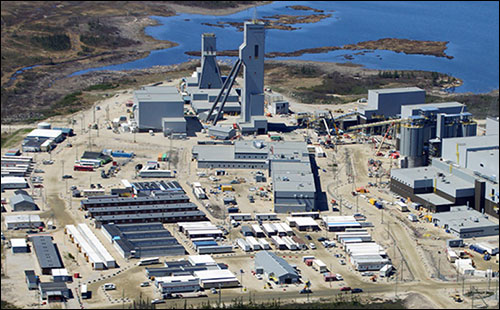Canadian mining company Goldcorp‘s new Éléonore gold mine, located roughly 500 miles north of Montreal, began production last fall. By 2018, three years into its expected 15-to-20 year lifespan, it should be moving 7,000 tons of ore daily via its network of shafts carved nearly 4,000 feet deep. Keeping such an operation humming along safely and efficiently is a task made easier thanks to a network of sensors that provide visibility into the movements and locations of workers and heavy equipment, while also assessing subterranean air quality, according to Guy Belleau, the mine’s general manager.
“With Wi-Fi in the underground mine, we can apply all kinds of technology and processes that allow us to track equipment and people on a real-time basis,” Belleau says. “It’s a super management tool, and all mines in the future will have this.”
The system is built on Cisco‘s Connected Mining solution, a network comprising 160 of Cisco’s Aironet 1500 and 3600 series access points, as well as its 5500 series wireless local area network (LAN) controller, which link to Cisco’s Catalyst switches, UBR7225VXR broadband routers and 2900 series integrated service routers. Linking into this communications backbone are Voice-over-Internet-Protocol phones, used to communicate with underground workers, as well as battery-powered RFID tags and telemetry units integrated into vehicles operated inside the mine. Each of the roughly 600 underground workers carries a helmet-mounted RFID tag, made by AeroScout, which transmits a unique ID number via a Wi-Fi connection to the Cisco access points, which provide coverage across 80 percent of the mine. The telemetry units are manufactured by ISSAC Instruments and communicate data over the Wi-Fi network as well.
The AeroScout tags are also attached to 200 vehicles and other heavy equipment, so that their location can be easily determined underground. Another 200 important mobile assets, such as welders and other tools, are also fitted with AeroScout tags.
Goldcorp personnel can access AeroScout’s MobileView software from computers, located either inside an underground control room or as far away as Goldcorp’s Vancouver headquarters, or via tablets that workers carry with them underground. There, they can view a map of the entire mine and see the locations of employees and assets, or drill down to search for specific individuals or things. Before blasting operations commence, the map, along with feeds from video cameras installed in the mines and linked into the Cisco network, can also help personnel ensure that the shafts are clear of people.
Another key part of the mine’s operation, Belleau explains, is an automated ventilation system that pumps warm, fresh air selectively, sending it only to the areas of the mine where it is needed, based on the presence of people and the operation of vehicles. It does this by tracking the locations of employees and vehicles, via the AeroScout tags, and by determining which vehicles are running at any given moment, as well as where they are located, based on signals from the location tags and telemetry units integrated into the mine vehicles. Based on this information and the levels of ambient carbon monoxide, propane and nitrogen dioxide in each part of the mine—which is monitored by Drager Polytron 8000 sensors wired to programmable logic controllers that are connected to cable modems and linked into the mine’s IT system via Cisco 7200 cable modem termination systems—the ventilation system determines where fresh air is required at all times.
Without leveraging this data from the sensors, RFID tags and telemetry system, the ventilation system would need to heat and blow 1.2 million cubic feet of air per minute into the mine. But by only supplying ventilation and heat as is necessary, Éléonore provides just 650,000 cubic feet of air per minute.
This, Belleau says, will translate into anywhere from $1.5 to $2.5 million in annual energy savings—as well as a significant reduction in carbon emissions, since the heating system is powered by propane. (All of the electrical power is pulled from the Hydro Quebec power grid, through transmission lines brought to the mine site along a 43-mile road built for the mine.)
The telemetry system also monitors 30 different functions and systems within each vehicle’s engine, and issues alerts to mine managers if any system shows signs of trouble. For example, if temperatures inside an engine surpass a threshold that could indicate a mechanical problem, or if a sensor detects a leak in the hydraulic line, the system generates an alert.
“If we see there is a high heat, we know—sometimes even before the truck operator knows—that there is an engine problem,” Belleau explains. “[Through this alert], the operator on the surface can tell the driver to bring the truck to the shop,” he says, so the issue can be diagnosed before the vehicle breaks down or overheats.
Goldcorp uses the telemetry system to monitor worker behavior, looking for signs of improper operation of heavy machines. What’s more, it can analyze engine data and vehicle speed in order to reconstruct events preceding a collision or an accident. It can auto-generate maintenance schedules within the mine’s enterprise resource planning (ERP) system, based on actual rather than estimated usage, by logging each machine’s hours of operation.
Instant access to employee location, on-demand ventilation and the capability to predict mechanical problems in vehicles combine to make Éléonore a cutting-edge mine, Belleau says, adding, “This is a dream for miners.”


